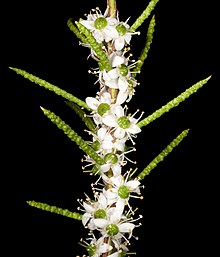Philotheca deserti
Philotheca deserti is a species of flowering plant in the family Rutaceae and is endemic to inland Western Australia. It is an erect shrub with narrow spindle-shaped, glandular-warty leaves and white flowers arranged singly in leaf axils.
| Philotheca deserti | |
|---|---|
 | |
| Near Beacon, Western Australia | |
| Scientific classification | |
| Kingdom: | Plantae |
| Clade: | Tracheophytes |
| Clade: | Angiosperms |
| Clade: | Eudicots |
| Clade: | Rosids |
| Order: | Sapindales |
| Family: | Rutaceae |
| Genus: | Philotheca |
| Species: | P. deserti |
| Binomial name | |
| Philotheca deserti | |
| Synonyms[1] | |
| |
Description
Philotheca deserti is a shrub that grows to a height of 1–2 m (3 ft 3 in–6 ft 7 in) with corky branchlets. The leaves are narrow spindle-shaped, glandular-warty, 20–30 mm (0.79–1.18 in) long and channelled on the upper surface. The flowers are usually borne singly, rarely in groups of two or three, in leaf axils, each flower on a pedicel 0.5–5.5 mm (0.020–0.217 in) long. There are five round sepals about 1 mm (0.039 in) long and five egg-shaped white petals about 3 mm (0.12 in) long. The ten stamens each are free from each other. Flowering occurs from April to June or in October and the fruit is about 2.5 mm (0.098 in) long with a short beak.[2][3]
Taxonomy and naming
This philotheca was first formally described in 1904 by Ernst Georg Pritzel who gave it the name Eriostemon desertii and published the description in Botanische Jahrbücher für Systematik, Pflanzengeschichte und Pflanzengeographie from specimens he collected near Southern Cross.[4][5] In 1998, Paul Wilson changed the name to Philotheca deserti and described two subspecies in the journal Nuytsia.[6][7]
Distribution and habitat
Philotheca deserti grows on undulating plains and hills between Kalgoorlie, Menzies and Yalgoo in the Avon Wheatbelt, Coolgardie and Murchison biogeographic regions.[2][3]
Conservation status
This species is classified as "not threatened" by the Western Australian Government Department of Parks and Wildlife,[3] but supspecies brevifolia is listed as "Priority Three" by the Government of Western Australia Department of Parks and Wildlife[10] meaning that it is poorly known and known from only a few locations but is not under imminent threat.[11]
References
- "Philotheca deserti". Australian Plant Census. Retrieved 1 August 2020.
- Wilson, Paul G.; Wilson, Annette J.G. (ed.) (2013). Flora of Australia (Volume 26). Canberra: Australian Biological Resources Study. pp. 375–376. Retrieved 2 August 2020.CS1 maint: extra text: authors list (link)
- "Philotheca deserti". FloraBase. Western Australian Government Department of Parks and Wildlife.
- Pritzel, Ernst Georg; Diels, Ludwig (ed.) (1904). "Fragmenta Phytographiae Australiae occidentalis. Beitrage zur Kenntnis der Pflanzen Westaustraliens, ihrer Verbreitung und ihrer Lebensverhaltnisse". Botanische Jahrbücher für Systematik, Pflanzengeschichte und Pflanzengeographie. 35 (3): 320. Retrieved 2 August 2020.CS1 maint: extra text: authors list (link)
- "Eriostemon desertii". APNI. Retrieved 2 August 2020.
- "Philotheca deserti". APNI. Retrieved 2 August 2020.
- Wilson, Paul G. (1998). "A Taxonomic Review of the genera Eriostemon and Philotheca". Nuytsia. 12 (2): 248. Retrieved 2 August 2020.
- "Philotheca deserti subsp. brevifolia". Australian Plant Census. Retrieved 2 August 2020.
- "Philotheca deserti subsp. deserti". Australian Plant Census. Retrieved 2 August 2020.
- "Philotheca deserti subsp. brevifolia". FloraBase. Western Australian Government Department of Parks and Wildlife.
- "Conservation codes for Western Australian Flora and Fauna" (PDF). Government of Western Australia Department of Parks and Wildlife. Retrieved 2 August 2020.